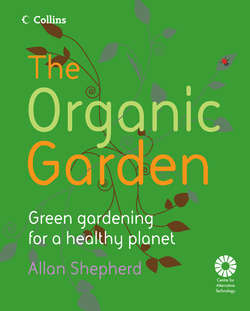Читать книгу The Organic Garden - Allan Shepherd - Страница 52
Other ecological considerations
ОглавлениеJenny and Mehdi’s structure is very much designed for summer use. If you want an all-year-round space, you need to think of your shed more like a miniature version of your house. Eco-homes use a range of techniques to make the most of natural heating and power sources and you can mimic these for your micro-house. Passive solar heating, the process of bringing more heat from the sun into a building, is a must for reducing winter fuel bills. At a basic level you can achieve it by giving your shed space large, south-facing windows, accompanied by smaller windows to the north. If you want to make the most of passive solar features I’d recommend getting hold of a book like CAT’s The Whole House Book. It’s packed full of useful information about green building materials and design features, most of which can be put to good use in a small structure like a shed or summerhouse. If you’re treating your shed as a stepping stone towards buying, making or renovating your own eco-home, it’s an essential purchase. The Whole House Book recommends the newer type of heat-loss-reducing glazing known as low-e glazing. It will also tell you what levels of insulation you require, and what heating options are available.
Kevin Beale (who built the straw bale shed on Robert Plant’s land) is now working on a home office in Snowdonia that includes a woodchip boiler. A woodchip boiler, although more expensive than a conventional solid fuel woodburner (for solid fuel systems check out www.solidfuel.co.uk and www.stovesonline.co.uk), is more environmentally efficient because the rate at which the fuel is burned can be controlled and so less fuel is used. Woodchip or wood pellet can be made from recycled wood waste and comes in bags. This makes fuel storage less of an issue. However, a woodchip boiler needs electricity to run a fan and a thermostat to control the burn rate, so you’ll need a power source.
You could generate your own power at home using solar PV systems or wind or water turbines, but it’s easier to switch to a green electricity supplier and buy renewable energy through the national grid. On a global scale it’s much more efficient to buy from a green supplier through the national grid than to install micro-power systems in every home. Check out www.foe.co.uk for supplier comparisons.
There are some situations where it will pay to go with your own system. Renewable energy systems are useful when the cost of linking to an existing power supply is prohibitively expensive. If you’re connecting your shed to the house electricity supply the work will need to be completed by a certified electrician. CAT has a whole range of renewable energy books and factsheets, many of which are available both as downloads and in paper form. They will tell you how to assess your power needs, choose the right system and get one installed. Visit www.cat.org.uk/catpubs.
Wind turbines are less efficient in built-up areas: they are best sited away from buildings, woodlands and other obstructions on flat open ground. I’ll touch on water collection overleaf but collecting water run-off from a shed roof will save time and money.
